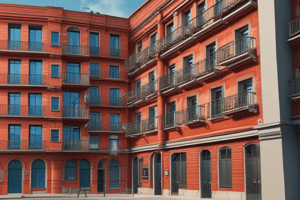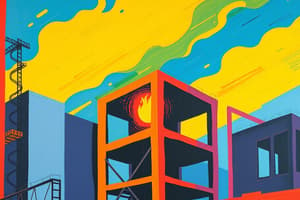Podcast
Questions and Answers
What are some of the hazards associated with smoke from fires?
What are some of the hazards associated with smoke from fires?
- Respiratory threat, reduced visibility, and inhalation of harmful toxins (correct)
- Heat exposure, disorientation, and long-term health risks
- Immediate unconsciousness, difficulty in avoiding obstacles, and odor detection
- Airtight areas, damp cloth usage, and gaseous components
What can help prevent inhalation of airborne particles when in a smoke-contaminated area?
What can help prevent inhalation of airborne particles when in a smoke-contaminated area?
- Avoiding areas contaminated with smoke
- Using a damp cloth to filter the air (correct)
- Moving toward the nearest exit
- Staying close to the ground
What are some characteristics of vapours produced by fires?
What are some characteristics of vapours produced by fires?
- They are always odorless and highly toxic
- They sink to ground level and pose a general respiratory hazard
- They can be either lighter or heavier than air, and can infiltrate non-hermetically sealed areas (correct)
- They rise and can be detected by their odor
What is the purpose of Alarm Monitoring Stations?
What is the purpose of Alarm Monitoring Stations?
What technology do smoke detectors use and where are they not suitable?
What technology do smoke detectors use and where are they not suitable?
What is the function of the jockey pump in the fire protection system?
What is the function of the jockey pump in the fire protection system?
What are the two primary types of fire control systems mentioned in the text?
What are the two primary types of fire control systems mentioned in the text?
Where is the Fire Alarm Panel typically located?
Where is the Fire Alarm Panel typically located?
When should fire panels reporting a fire alarm be reset?
When should fire panels reporting a fire alarm be reset?
What is the purpose of the built-in delay in automated suppression systems?
What is the purpose of the built-in delay in automated suppression systems?
When are fire watch patrols required?
When are fire watch patrols required?
What is the primary function of manually operated equipment like fire hose cabinets and fire extinguishers?
What is the primary function of manually operated equipment like fire hose cabinets and fire extinguishers?
What activates kitchen fire suppression systems?
What activates kitchen fire suppression systems?
What distinguishes firefighter’s elevators from standard passenger elevators?
What distinguishes firefighter’s elevators from standard passenger elevators?
Under what conditions should security guards engage in firefighting activities?
Under what conditions should security guards engage in firefighting activities?
What is the purpose of the built-in delay in automated suppression systems?
What is the purpose of the built-in delay in automated suppression systems?
What is the primary function of manually operated equipment like fire hose cabinets and fire extinguishers?
What is the primary function of manually operated equipment like fire hose cabinets and fire extinguishers?
When are security guards allowed to engage in firefighting activities?
When are security guards allowed to engage in firefighting activities?
What triggers the activation of kitchen fire suppression systems?
What triggers the activation of kitchen fire suppression systems?
What is the purpose of fire watch patrols?
What is the purpose of fire watch patrols?
What distinguishes firefighter's elevators from standard passenger elevators?
What distinguishes firefighter's elevators from standard passenger elevators?
Study Notes
Fire Safety and Security Procedures in Buildings
- Alternative fire suppression systems are installed in areas where water could damage sensitive equipment, such as computer rooms.
- Security guards must understand the technical aspects of these systems to manage health risks and hazardous environments.
- Automated suppression systems have a built-in delay to allow safe evacuation before the suppression agent is released.
- Manually operated equipment, like fire hose cabinets and fire extinguishers, serve as means to clear escape routes in emergencies.
- Fire extinguishers come in various types and must be regularly inspected by security guards to ensure functionality.
- Kitchen fire suppression systems are typically activated by a switch or pull-type lever and release similar agents to portable fire extinguishers.
- Elevators have specific procedures during a fire emergency, including automatic descent and recall functions.
- Firefighter’s elevators are distinct from standard passenger elevators and have specific operational procedures during fire emergencies.
- Fire watch patrols are required when a fire protection system becomes non-operational, involving human presence checking for fire signs at least once per hour.
- Firefighters undergo extensive training and are equipped with protective gear; they work in teams of at least two individuals.
- Security guards should only engage in firefighting activities under specific conditions, such as using a fire extinguisher after the general alarm has been activated and when trained to do so.
- Prompt communication with property management and the Fire Department is crucial when conducting fire watch patrols or encountering service disruptions in fire protection systems.
Studying That Suits You
Use AI to generate personalized quizzes and flashcards to suit your learning preferences.
Description
Test your knowledge of fire safety and security procedures in buildings with this quiz. Explore topics such as alternative fire suppression systems, manual and automated equipment, elevator procedures, fire watch patrols, and the role of security guards in managing fire risks.




